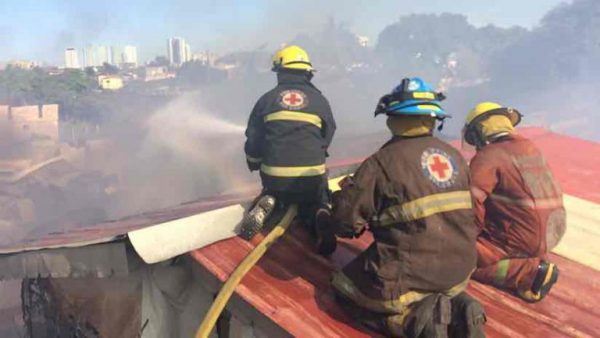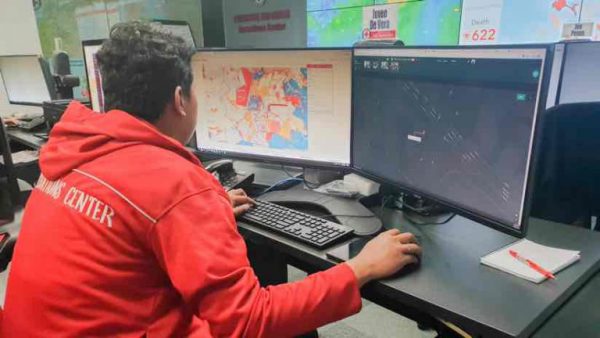
24 Sep Smart Maps Help Philippine Red Cross Respond Quickly to Hundreds of Disasters
Located in the Ring of Fire—a region of the Pacific Ocean prone to earthquakes and volcanic eruptions—and facing year-round typhoons, the Philippines routinely endures natural disasters. When a storm, landslide, fire, or flooding hits, the Philippine Red Cross Operations Center mobilizes staff and volunteers to examine a digital map of the area, then determines how best to respond.
During a disaster, the more than 600,000 volunteers of the Philippine Red Cross work to collect on-the-ground data. They feed that information into the organization’s geographic information system (GIS), the technology that enables map making and provides a real-time common operating picture.
The GIS-based map—developed in partnership with the Norwegian Red Cross and DNV GL—enables staff to determine the number of residents impacted by the event along with available resources such as evacuation centers, emergency vehicles, and drinking water inventory. The system even contains information about residential construction materials, which can help first responders assess damage.
Today, these teams are equipped with accurate maps and data. In the past though, this work was much more of a struggle..
A Need for Smart Maps
The Philippines ranks third on the World Risk Index, which measures exposure to natural and biological hazards. The Philippine Red Cross serves the country’s population of more than 100 million people spread across 7,600 islands.
In 2013, the Philippines fell victim to three major emergencies. Typhoon Haiyan, one of the largest and strongest typhoons ever recorded, killed more than 7,000 people and displaced thousands more. A magnitude 7.2 earthquake impacting Bohol Island damaged or leveled homes, ports, schools, airports, and a hospital killing more than 200 people, injuring scores more, and triggering a deadly landslide. And, a humanitarian crisis caused by the armed conflict in Zamboanga City displaced more than 100,000 citizens and destroyed more than 10,000 homes.
At that point, the Red Cross was making simple maps for disaster preparedness and response and lacked the technology to answer critical questions in any disaster: How many people could be affected? What are their needs right now? How can we get them immediate help?
Following the Formula for Response
The Red Cross formula for effective disaster response is, “trained volunteers, plus logistics, plus information technology.” Before 2014, the Philippines, the Red Cross needed to address the last component of the equation.
“We didn’t have any digital mapping capabilities. If I needed to provide just one map, it would take me four hours,” recalls May Layugan, manager of the Philippine Red Cross operations center. “When a disaster strikes, we need answers to crucial questions as quickly as possible.”.
Layugan advocated for the Red Cross to adopt a single platform equipped with spatial analysis software. The Red Cross leadership, headed by chairman and CEO Richard Gordon, supported the complete modernization of the operations center. That’s when it implemented GIS and gained the ability to integrate disparate data into smart maps with drag-and-drop functionality.
Fast-forward five years and now the Philippine Red Cross has expanded its use of GIS beyond mapmaking and into operations. “If something happened in a distant area before, we really didn’t know who to call,” Layugan said. “Now, we have all of our 650,000 volunteers mapped, and we can quickly search any area and instantly know who to mobilize and which resources to allocate at a moment’s notice.”
Adding Communities to the Map
Even though much of the world has been mapped to precise detail, there remained a number of communities across the Philippines that did not exist on maps. This left some populations less visible to Red Cross workers, making it difficult to provide timely response during a crisis.
With the GIS in place, Red Cross staff could fill the gaps in coverage. The organization selected and trained volunteers who have intimate knowledge of their respective barangays, or neighborhoods. These volunteers conduct participatory capacity and vulnerability assessments for each of the country’s 42,000 barangays.
“We established a mutually-beneficial partnership with local governments and the barangay captains where the community itself is helping us help them,” Layugan said. “Our volunteers capture information and images using an app that feeds directly into our GIS. They mark the vulnerabilities of a barangay, such as what areas are prone to flooding, how many people have a disability or are pregnant, so that we know our priorities.”
The Philippine Red Cross then partnered with various government departments to visualize the location of schools, hospitals, police stations, and other community assets all on one map. “We have even mapped the location of doctors and nurses in case there’s a mass casualty incident and we need to mobilize our emergency hospitals,” Layugan added. “When there’s a disaster, we have the manpower and the infrastructure to respond.”
Leveraging Mobile Apps and Social Media
The barangay assessments serve as foundational data for disaster response, enabling the Red Cross to determine the level of need for each community.
“Putting information on a real-time map empowers volunteers to be proactive—mobilizing and helping one another,” Layugan said. “For example, when it starts to rain heavily, they know exactly how to respond and do not need to be instructed to evacuate.”
Noticing the extent to which volunteers were using social media, the Philippine Red Cross created separate social media messenger groups. After an event, the groups are used to reach and deploy volunteers to assess damages in each barangay.
“When there’s an incident, we just send one message and every one of them receives it,” Layugan said. “We use social media to update these groups and recognize those that have sent in their status reports.” The system also tracks humanitarian efforts of the various entities from other countries working in the Philippines, such as from the International Federation of Red Cross and Red Crescent Societies, who all lend a hand. Coordinating these efforts has proven challenging in the past.
“It’s very easy for us to map the location of who is working where so there is no duplication,” Layugan said. “We know what communities are over-served, underserved or not served at all.”



